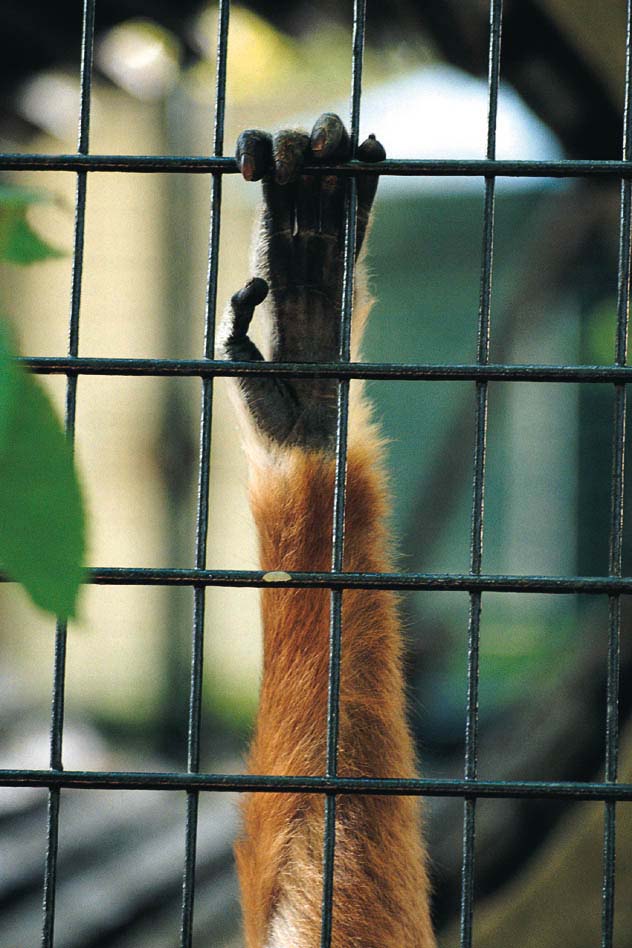Slide 1 of 4: Introduction
Author: Ronald J. Comer, Princeton University
Press the Next button to start this activity

Slide 2 of 4: 26.1 "Wire Mothers" and Attachment: Harlow’s Monkeys
In this classic 1960 footage, famous researcher Harry Harlow demonstrates how his work with rhesus monkeys sheds light on the development of attachment and "mother love." Harlow conducts experiments in which monkeys who have been raised with an artificial mother made out of wire, which provides milk, nevertheless turn to artificial mothers made of cloth in times of distress or in unfamiliar surroundings. Harlow exposes the monkeys to frightening artificial robot threats, and finds that there is an innate craving by the monkeys for soft tactile comforting touch—touch that cannot be provided by a "wire mother," even one that has been solely responsible for the nursing of the monkeys.
"Wire Mothers" and Attachment: Harlow's Monkeys
He reminds me of a baby that's been given back his favorite blanket or toy.
Exactly, and this simple, basic reaction made us believe that we could define and measure what had previously been undefinable and unmeasurable, the baby's love for its mother. Some people believe that this is built upon nursing. But is it not possible that this is formed from a need to cling and cuddle, a need for contact comfort?
Now obviously, in doing these researches, we cannot use real, human mothers and human babies. But we think we have the best possible substitute, a baby rhesus monkey. The responses of the baby monkey are very similar to those of a human baby. But in conducting these researches, we ran into a very difficult problem, to create an inanimate substitute mother over which we would have complete experimental control but a mother which the baby would love.
Now this is what we tried. We constructed two substitute mothers. Now, this is the wire mother. We can build out or build in nursing as we desire. This is the cloth mother.
These are the only mothers these babies ever had. Half of the babies nursed on the wire mother only, the other half on the cloth mother. But both mothers were always available in the cages. And now for the real question-- to which mother is there an emotional response? Let me show you a monkey raised on a nursing wire mother.
Now, here are 106's two mothers. As you can see, it was weaned on a wire mother. Here is baby 106. Watch.
He's going to the wire mother.
He's got to eat to live.
Oh, he's going back.
He's back on the cloth mother, and he'll stay on the cloth mother. Actually, this baby spends from 17 to 18 hours a day on the cloth mother and less than one hour a day on the wire mother.
Now in this experiment, this is the apparatus we use.
That looks diabolical.
That's just the way the baby monkey feels about it Flashing eyes, loud sounds, moving mechanical parts-- all of these things are designed to frighten a monkey. Now here we have a peaceful, resting baby monkey. Let's find out what his reactions to his mother are when we frighten him.
[MONKEY SCREAMS]
He's scared, all right.
And he does what any child will do in a similar situation.
He runs away.
It's more than running away. He was running to his mother, to touch her, to drive away his fear. Contact with the mother changes his entire personality. Look, now he's actually threatening the diabolical object. All right, this gives us part of the picture of the strength of infantile love.
This is a 6-foot square room with a few toys and other objects. But to the monkey, it's much more menacing. We know that when our own children are taken to a strange place without the mothers, they are often overwhelmed with fear. This room is just such a new and strange environment for the baby monkeys. No mother is in there.
Now, let's put a monkey into the room. Notice how cautiously he enters the room. He's searching for comfort, but nothing relieves his disturbance. Now we'll take the baby monkey out and put in a wire mother.
Now this one was nursed by a wire mother.
That's right, all his life.
She doesn't seem to help much.
Now, we'll try the same test with a cloth mother in the room. You see the contrast in the behavior? Despite the fact that the wire more nursed him, she could offer this infant nothing in the way of affection or security. But here, the monkey, by rubbing against the cloth mother as if he were seeking as much contact comfort as he could get, builds up his reservoir of affection and security.
First his body relaxes as the fear disappears. But above and beyond this, new, positive response patterns appear. He now goes out to explore and investigate this new, strange world. He is now a normal, happy, curious baby.
Slide 3 of 4: 26.2 Check Your Understanding
Instructions:
Answer the questions based on the video and your reading of the entire chapter.
Slide 4 of 4: 26.3 Activity Completed!
Activity results are being submitted...